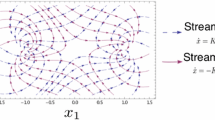Abstract
We introduce a method of generating systematic mean field (MF) approximations for the nonequilibrium steady state of ferromagnetic Ising driven diffusive systems (DDS), based on the maximum entropy principle due to Jaynes. In the phase coexistence region, MF approximations to the master equation do not provide a closed system of equations in the MF variables. This can be traced to the conservation of the order parameter by the stochastic dynamics. Our maximum entropy mean field (MEMF) approximation method is applicable to high temperatures as well to the low-temperature phase coexistence region. It is based on a derivation of a generalized variational free energy from the maximum entropy principle, with the MF evolution equations playing the role of constraints. In the phase coexistence region this free energy is nonconvex and is interpreted by means of a Maxwell construction. We use a pair-level variant of the MEMF approximation to calculate quantities of interest for the ferro-magnetic Ising DDS on a square lattice. Results of calculations with several different choices of transition rates satisfying local detailed balance are discussed and compared with those obtained by other methods.
Similar content being viewed by others
References
S. Katz, J. L. Lebowitz, and H. Spohn,Phys. Rev. B 28:1655 (1983).
S. Katz, J. L. Lebowitz, and H. Spohn,J. Stat. Phys. 34:497 (1984).
R. J. Glauber,J. Math. Phys. 4:294 (1963).
K. Kawasaki,Phys. Rev. 145:224 (1966).
K. Kawasaki, inPhase Transitions and Critical Phenomena, Vol. 2, C. Domb and M. S. Green, eds. (Academic Press, New York, 1972).
E. T. Jaynes,Phys. Rev. 106:620 (1957).
E. T. Jaynes,Phys. Rev. 108:171 (1957).
E. T. Jaynes, inPapers on Probability, Statistics and Statistical Physics, R. D. Rosenkrantz, ed. (Reidel, Dordrecht, 1983).
W. T. Grandy, Jr.,Foundations of Statistical Mechanics, (Reidel, Dordrecht, 1987).
C. R. Smith and W. T. Grandy, Jr., eds.Maximum-Entropy and Bayesian Methods in Inverse Problems (Reidel, Dordrecht, 1985).
R. Dickman,Phys. Rev. A 38:2588 (1989).
R. G. Bowers and A. McKerrel,Am. J. Phys. 46:138 (1978).
J. Krug, J. L. Lebowitz, H. Spohn, and M. Q. Zhang,J. Stat. Phys. 44:535 (1986).
J. Marro, J. L. Lebowitz, H. Spohn, and M. H. Kalos,J. Stat. Phys. 38:725 (1985).
J. L. Valles and J. Marro,J. Stat. Phys. 49:89 (1987).
K. Leung and J. L. Cardy,J. Stat. Phys. 44:567 (1986).
H. K. Janssen and B. Schmittmann,Z. Phys. B 64:503 (1986).
J. L. Valles and J. Marro,J. Stat. Phys. 43:441 (1986).
J. Marro, J. L. Valles, and J. M. Gonzales-Miranda,Phys. Rev. B 35:3372 (1987).
K. T. Leung,Phys. Rev. Lett. 66:453 (1991).
H. van Beijeren and L. S. Schulman,Phys. Rev. Lett. 53:806 (1984).
R. Dickman,Phys. Rev. A 41:2192 (1990).
P. L. Garrido, J. Marro, and R. Dickman,Ann. Phys. 199:366 (1990).
B. Schmittmann,Int. J. Mod. Phys. B 4:2269 (1990).
R. Kikuchi,Phys. Rev. 81:988 (1951).
T. Morita,J. Phys. Soc. Jpn. 12:753 (1957).
N. G. van Kampen, inAdvances in Chemical Physics, Vol. 34, I. Prigogine and S. A. Rice, eds. (Wiley, New York, 1976), p. 245.
C. M. van Baal,Physica A 111:591 (1982).
I. I. Kidin and M. A. Shtremel,Fiz. Metal. Metalloved. 11:641 (1961).
N. Pesheva, Derivation of the macroscopic rate equations for DDS at pair level of approximation, to be published.
I. Procaccia and J. Ross,J. Chem. Phys. 67:5558 (1977).
I. Procaccia, Y. Shimoni, and R. D. Levine,J. Chem. Phys. 65:3284 (1976).
I. Procaccia and R. D. Levine,J. Chem. Phys. 65:3357 (1976).
M. Suzuki,J. Phys. Soc. Jpn. 55:4205 (1986).
M. Suzuki, M. Katori, and X. Hu,J. Phys. Soc. Jpn. 56:3092 (1987).
Author information
Authors and Affiliations
Rights and permissions
About this article
Cite this article
Pesheva, N.C., Shnidman, Y. & Zia, R.K.P. A maximum entropy mean field method for driven diffusive systems. J Stat Phys 70, 737–771 (1993). https://doi.org/10.1007/BF01053593
Received:
Revised:
Issue Date:
DOI: https://doi.org/10.1007/BF01053593




